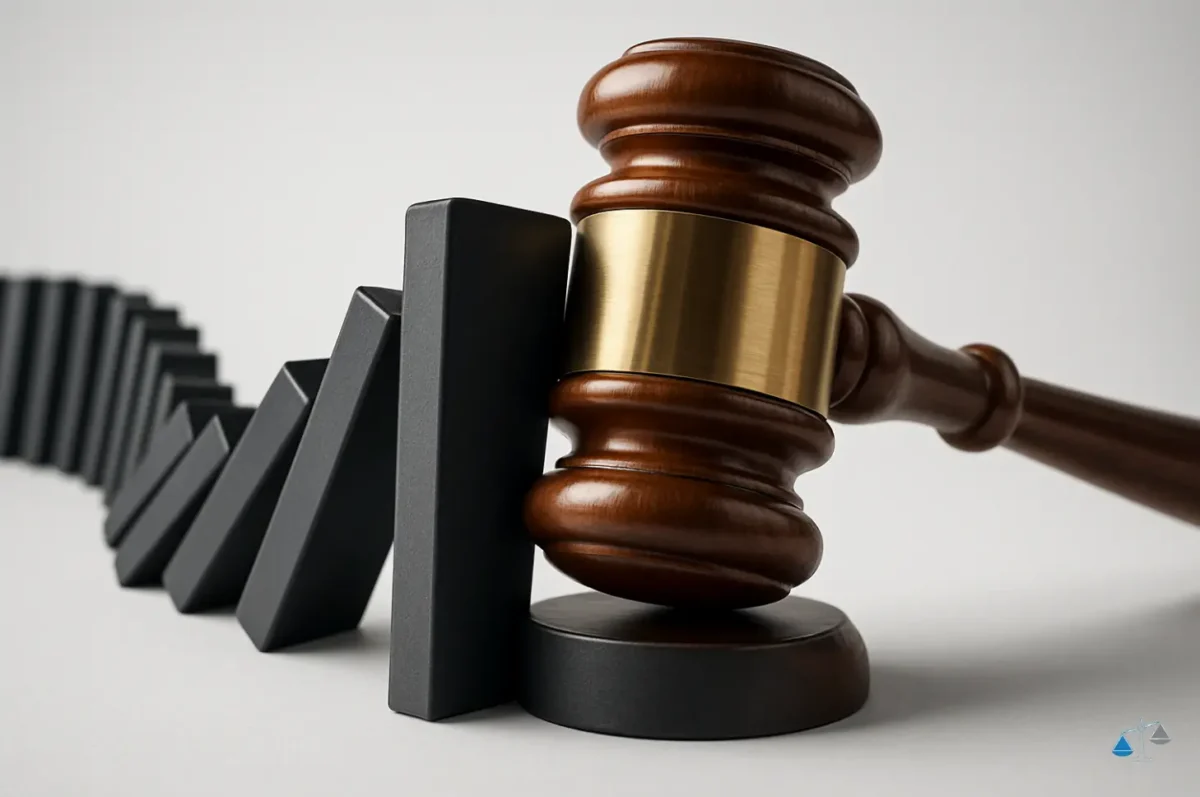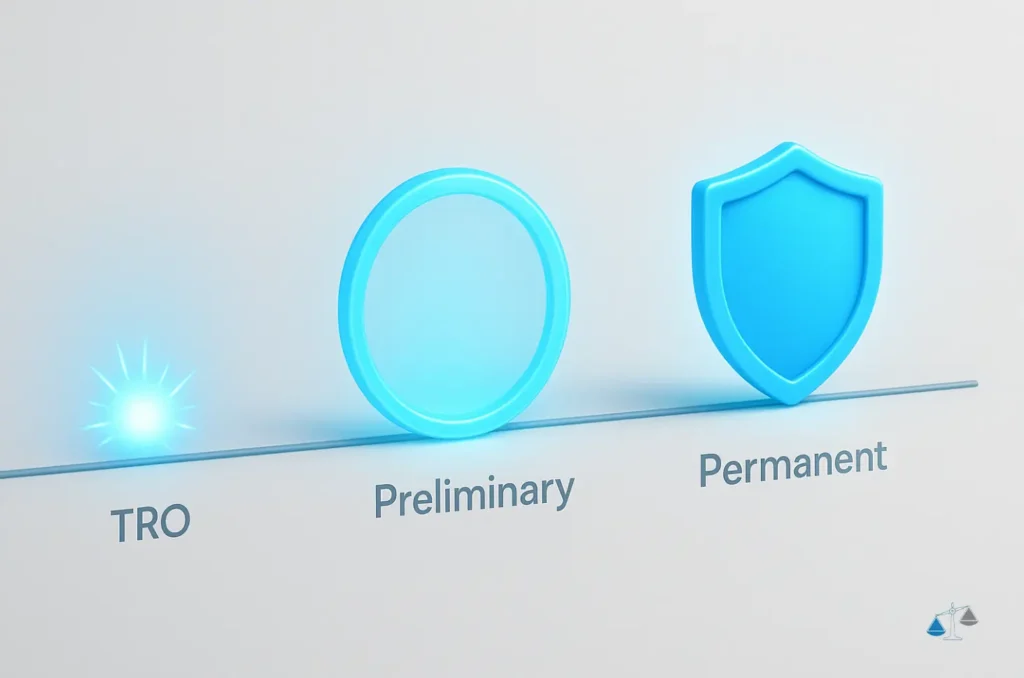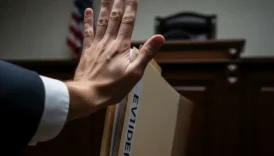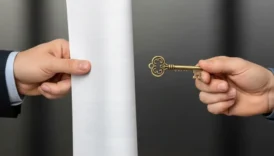Injunctive Relief: Meaning and Definition

- Injunctive Relief: Meaning and Definition
- A Plain-English Definition: What Does "Injunctive Relief" Actually Mean?
- Beyond Money: Understanding When Damages Aren't Enough
- The Core Purpose: To Prevent or Stop Irreparable Harm
- The 3 Key Types of Injunctive Relief Explained
- 1. Temporary Restraining Order (TRO): The Emergency Stop Button
- 2. Preliminary Injunction: A Temporary Hold During the Lawsuit
- 3. Permanent Injunction: The Final Ruling After a Trial
- How Does a Court Decide to Grant an Injunction? The 4-Factor Test
- Factor 1: Likelihood of Success on the Merits
- Factor 2: Risk of Irreparable Harm
- Factor 3: The Balance of Hardships
- Factor 4: The Public Interest
- Real-World Examples of Injunctive Relief in Action
- Intellectual Property: Stopping the Sale of Counterfeit Goods
- Business Disputes: Enforcing a Non-Compete Clause
- Real Estate: Halting an Unlawful Demolition
- Defamation: Preventing the Spread of False Statements
- What Happens if Someone Ignores an Injunction?
- Understanding Contempt of Court: Fines and Other Penalties
- Conclusion: A Powerful but "Extraordinary" Legal Remedy
- FAQ About Injunctive Relief
- What is the difference between injunctive relief and monetary damages?
- Is a restraining order the same as an injunction?
- How long does an injunction last?
- Is it difficult to obtain an injunctive relief?
- Can you appeal a court's decision on an injunction?
Imagine a construction company is about to bulldoze a historic building in your town, or a former employee is minutes away from leaking your company’s secret formula to a competitor. In these situations, getting a check for damages later won’t undo the harm. The building will still be gone, and the secret will still be out. This is where a powerful legal tool called injunctive relief comes into play.
A Plain-English Definition: What Does “Injunctive Relief” Actually Mean?
At its core, injunctive relief is a court order that either compels someone to do something or prohibits them from doing something. Unlike most legal remedies that involve paying money (known as monetary damages) after the damage is done, an injunction is proactive. It’s the law stepping in to press the “pause” or “stop” button before irreversible damage can occur.
Beyond Money: Understanding When Damages Aren’t Enough
The legal system’s default solution is often to award money to the wronged party. If someone damages your car, they can pay for the repairs. But what if the issue is something unique and irreplaceable?
- A company is about to cut down a forest of ancient, protected trees.
- A publisher is about to release a book containing defamatory lies about you.
- An ex-partner is threatening to release private photos online.
In these cases, no amount of money can truly fix the problem once it happens. The harm is “irreparable.” Injunctive relief exists precisely for these scenarios where monetary damages are an inadequate solution.
The Core Purpose: To Prevent or Stop Irreparable Harm
The single most important goal of an injunction is to preserve the status quo and prevent irreparable harm. It’s a judge’s way of saying, “Hold on. We need to stop this action right now until we can figure out the legal rights of everyone involved.” Whether it’s stopping a trademark infringement, preventing a hostile takeover, or halting illegal pollution, the objective is always to intervene before it’s too late.
The 3 Key Types of Injunctive Relief Explained

Not all legal disputes require the same level of urgency or finality. Because of this, courts use three distinct types of injunctions, each serving a different purpose and lasting for a different duration. Think of them as escalating levels of intervention.
1. Temporary Restraining Order (TRO): The Emergency Stop Button
A Temporary Restraining Order (TRO) is the most urgent and immediate form of injunctive relief. It acts like an emergency brake, designed to stop potentially damaging actions for a very short period—often just a few days.
The key feature of a TRO is speed. It can sometimes be granted ex parte, meaning a judge can issue it without the other party even being present for the hearing. This happens in critical situations where giving notice could cause the defendant to quickly perform the harmful act (e.g., shredding documents or transferring funds). A TRO’s sole purpose is to freeze the situation just long enough for the court to schedule a more formal hearing for a preliminary injunction.
2. Preliminary Injunction: A Temporary Hold During the Lawsuit
After a TRO is issued (or if the situation isn’t an immediate emergency), the court will consider a Preliminary Injunction. This is a more durable solution that maintains the status quo while the entire lawsuit is pending, which could be months or even years.
Unlike a TRO, a preliminary injunction is only granted after a court hearing where both sides have the opportunity to present arguments and evidence. The judge weighs the situation more carefully to decide if the restrictions should remain in place until a final verdict is reached. It’s a crucial bridge that prevents either party from taking actions that could render the final judgment meaningless.
3. Permanent Injunction: The Final Ruling After a Trial
The Permanent Injunction is the final destination. It is not temporary. This order is issued only after a full trial on the merits of the case, where a judge or jury has concluded that one party is legally in the right.
If the court grants a permanent injunction, it becomes a final judgment in the case. The order can require a party to either do something or refrain from doing something indefinitely or for a specific period defined by the court. For example, a company found guilty of patent infringement might be permanently enjoined from ever selling that specific product again.
How Does a Court Decide to Grant an Injunction? The 4-Factor Test
Judges do not grant injunctions lightly. Because ordering someone to stop or start an action is a significant exercise of power, it is considered an “extraordinary remedy.” To ensure the decision is fair, courts in the U.S. typically use a well-established framework known as the four-factor test. The party requesting the injunction must convincingly argue all four points.
Factor 1: Likelihood of Success on the Merits
First, the court needs to be convinced that the person asking for the injunction (the plaintiff) has a strong case and is likely to win the overall lawsuit. They don’t have to prove their case completely at this early stage, but they must show a reasonable probability of success. Essentially, the judge asks: “Does this claim appear valid and supported by law, or is it frivolous?”
Factor 2: Risk of Irreparable Harm
This is often the most critical factor. As discussed earlier, the plaintiff must demonstrate that they will suffer irreparable harm if the injunction is not granted. This harm must be something that money can’t fix. The loss of a unique piece of art, the destruction of a company’s reputation, or the exposure of a trade secret are all classic examples of irreparable harm. If the damage can be easily calculated and compensated with a check later, the court will likely deny the injunction.
Factor 3: The Balance of Hardships
Here, the court acts like a scale, weighing the potential harm on both sides. It assesses the damage the plaintiff will suffer if the injunction is denied against the damage the defendant will suffer if the injunction is granted. For the injunction to be approved, the scale must tip in the plaintiff’s favor. The harm to the plaintiff without the injunction must be significantly greater than the harm the defendant would face from being forced to stop their actions.
Factor 4: The Public Interest
Finally, the court may consider whether granting the injunction would serve the public interest. This factor is not relevant in every private dispute, but it becomes crucial in cases that affect the broader community. For example, a court would heavily weigh the public interest in a case seeking to halt the sale of a dangerous drug, stop environmental pollution, or prevent an illegal merger that could harm consumers. The judge asks: “Will this order benefit or harm society as a whole?”
Anlaştık, devam ediyorum. Konunun daha somut hale gelmesi için gerçek dünya örneklerini içeren bölüm aşağıdadır.
Real-World Examples of Injunctive Relief in Action
Understanding the four-factor test is helpful, but seeing how injunctive relief works in practice makes the concept much clearer. This legal tool is used across various fields of law to address urgent problems. Here are some common scenarios.
Intellectual Property: Stopping the Sale of Counterfeit Goods
Imagine a luxury handbag designer discovers a warehouse full of high-quality fakes about to hit the market. Suing for monetary damages after the bags are sold is a messy, incomplete solution. The company’s brand reputation would be damaged, and calculating the full extent of the loss would be nearly impossible.
Instead, the designer can seek an injunction to immediately stop the sale, distribution, and importation of the counterfeit goods. This prevents the irreparable harm to their brand and intellectual property before it can spread.
Business Disputes: Enforcing a Non-Compete Clause
A high-level software engineer with deep knowledge of her company’s trade secrets resigns and immediately accepts a job at a direct competitor. Her employment contract included a non-compete clause preventing this exact move for one year.
The original company can ask a court for an injunction to prohibit her from working for the competitor for the duration specified in the contract. The irreparable harm isn’t just the loss of an employee; it’s the imminent threat that confidential strategic plans and proprietary code will be shared, giving the competitor an unfair advantage that money can’t reverse.
Real Estate: Halting an Unlawful Demolition
A property developer plans to demolish a historic, albeit neglected, building to construct a new office block. A local historical society believes the building is protected by landmark laws and files a lawsuit.
While the case is being decided, the society can request a preliminary injunction to prevent the demolition. The irreparable harm is self-evident: if the bulldozers move in, the historic structure will be lost forever, and no court ruling or monetary award can bring it back. The injunction preserves the very subject of the lawsuit until a final decision is made.
Defamation: Preventing the Spread of False Statements
In certain situations, a person may seek an injunction to stop the publication of false and defamatory statements. For instance, if a media outlet is about to publish a story that is verifiably false and would cause immediate, severe damage to an individual’s career and personal life.
This is often the most difficult type of injunction to get because of strong protections for free speech (like the First Amendment in the U.S.). However, it serves as an example of how injunctive relief can be used to prevent damage to one’s reputation, which is another form of harm that is hard to quantify and repair with money alone.
What Happens if Someone Ignores an Injunction?
A court-issued injunction is not a suggestion—it is a direct, legally binding command. Willfully defying one carries severe consequences, as it is seen as a direct challenge to the authority of the court itself.
Understanding Contempt of Court: Fines and Other Penalties
When a person or entity violates an injunction, they can be held in contempt of court. The penalties are designed to force compliance and punish the disobedience. This can include:
- Significant Fines: A court can impose a fixed financial penalty or daily fines that accumulate for every day the order is violated.
- Coercive Imprisonment: In more extreme cases, a judge can order the disobedient party to be jailed until they agree to comply with the injunction.
- Payment of Attorney’s Fees: The violating party may be ordered to pay the legal costs the other party incurred to enforce the injunction.
These tools ensure that injunctive relief is not just a piece of paper, but an order with real power behind it.
Conclusion: A Powerful but “Extraordinary” Legal Remedy
Injunctive relief stands as a critical pillar of the justice system, offering a solution when money simply isn’t enough. It acts proactively to prevent irreversible harm, from protecting priceless intellectual property to preserving historic landmarks. By understanding its key forms—the emergency TRO, the lawsuit-spanning preliminary injunction, and the decisive permanent injunction—we can appreciate its flexibility.
However, its power is matched by the caution with which courts grant it. The rigorous four-factor test ensures that this “extraordinary remedy” is reserved for situations where it is truly necessary and just. It is a testament to the legal system’s ability to do more than just compensate for damage, but to actively prevent injustice from happening in the first place.
FAQ About Injunctive Relief
What is the difference between injunctive relief and monetary damages?
The key difference is timing and purpose. Injunctive relief is a proactive court order to prevent future harm by stopping or compelling an action. Monetary damages are a reactive remedy that compensates a party with money for harm that has already occurred.
Is a restraining order the same as an injunction?
Yes, a restraining order is a specific type of injunction. The term “Temporary Restraining Order” (TRO) is the formal legal name. While often associated with domestic disputes, the term legally refers to the most urgent form of injunctive relief.
How long does an injunction last?
It depends on the type. A Temporary Restraining Order (TRO) is very short-term, often lasting only a few days to a couple of weeks. A preliminary injunction lasts for the duration of the underlying lawsuit. A permanent injunction, issued after a final trial verdict, can last for a specified period or even forever.
Is it difficult to obtain an injunctive relief?
Yes. Courts consider it an “extraordinary remedy,” not a standard one. The party seeking the injunction has the burden of proving all elements of the four-factor test, with a special focus on demonstrating they will suffer irreparable harm if the injunction is not granted.
Can you appeal a court’s decision on an injunction?
Generally, yes. A court’s decision to grant or deny a preliminary or permanent injunction can be appealed to a higher court. However, the appeals process is complex, and appellate courts typically give significant deference to the trial court’s initial decision.






